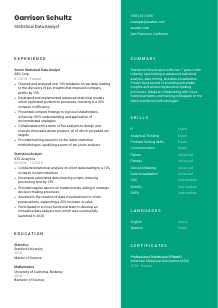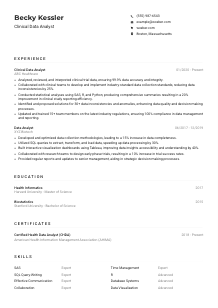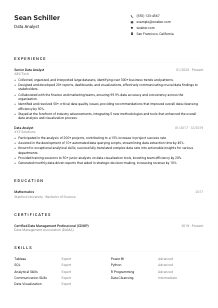Statistical Data Analyst Resume Example
Unraveling the secrets of data, but your resume feels off-center? Dive into this Statistical Data Analyst resume example, finessed with Wozber free resume builder. Show how you can map your analytical prowess to align with job specifications, creating a career graph that always trends upward!

How to write a Statistical Data Analyst Resume?
Hello, aspiring Statistical Data Analyst! In your quest to break into or excel further in the data-driven world, your resume is not just a paper trail of your journey; it's your golden ticket to your next big opportunity. With the precision of a well-crafted algorithm, let's guide you through creating a resume that not only ticks all the boxes but makes you the standout candidate for the role. Using the Wozber free resume builder, we'll navigate the landscape of ATS-optimization with an ATS-friendly resume template, ensuring your resume navigates through Applicant Tracking Systems (ATS) with the same finesse you apply to your data observations.
Gearing up? Let's turn those numbers in your favor!
Personal Details
The Personal Details section is your resume's header, greeting hiring managers with a crisp snapshot of who you are. Let's turn this section into a strategic asset, aligning it perfectly with your dream Statistical Data Analyst role.
1. Brand Thy Name
Your name is more than a label; it's the lead in your professional narrative. Let it shine in a clear, sizable font at the top. This isn't just about visibility; it's about establishing your professional presence right off the bat.
2. Job Title Alignment
Beneath your name, mirror the job title you're targeting. For instance, 'Statistical Data Analyst' directly under your name instantly bridges your identity with the role you're after, telling the hiring manager that you're not just any candidate—you're the candidate.
3. Essential Contact Details
In this digital era, your phone number and a professional email address (think firstname.lastname@domain.com) are non-negotiables. Precision here signals your attention to detail—an attribute every data analyst must possess. And yes, ensure zero typos.
4. Geolocation Matters
"Must be located in or willing to relocate to San Francisco, California." If this matches your situation, make it clear in your contact section. Aligning your location with the job's geography can sometimes make or break your application.
5. Online Presence
Include a LinkedIn profile or personal website if it showcases your professional journey or portfolio. Ensure they are pristine reflections of your resume, adding depth to your application and giving a broader view of your professional essence.
Takeaway
Your Personal Details section is the doorway inviting recruiters into your professional world. Ensure it's not just informative but aligned with the essence of a Statistical Data Analyst role. It's your first impression—make it count.





Experience
The Experience section is where the substance of your career unfolds. For a Statistical Data Analyst, this isn't just about listing job titles; it's about narrating your journey through your achievements and how they make you the ideal candidate for the role.
- Cleaned and analyzed over 100 terabytes of raw data, leading to the discovery of key insights that improved company profits by 15%.
- Developed and implemented advanced statistical models which optimized production processes, resulting in a 20% increase in efficiency.
- Presented complex findings to top‑level stakeholders, achieving 100% understanding and application of recommended strategies.
- Collaborated with a team of five analysts to design and execute three data‑driven projects, all of which exceeded set targets.
- Provided training sessions on the latest statistical methodologies, upskilling a team of ten junior analysts.
- Conducted statistical analysis on client data leading to a 10% increase in client retention.
- Developed automated data cleaning scripts, reducing processing time by 25%.
- Provided regular reports on market trends, aiding in strategic decision‑making processes.
- Assisted in the creation of data visualizations for client presentations, supporting a 20% increase in sales.
- Participated in a cross‑functional team to develop an innovative data analysis tool, which was successfully launched in 2020.
1. Digesting Requirements
Begin by breaking down the job requirements. For instance, "Develop and implement statistical models" or "Present findings to stakeholders." These aren't just tasks; they're your playbook for tailoring your job descriptions.
2. Chronological Storytelling
Start with your most recent position and craft a storyline that speaks to your growth and achievements, specifically in statistical analysis and data visualization. This isn't just a timeline; it's the plot of your professional evolution.
3. Achievement Highlights
Each bullet point under your roles should be a testament to your impact. Did you optimize production processes by 20%? Spell it out. These specifics serve as tangible markers of your success and potential value to the new role.
4. Quantify Your Impact
Data speaks louder in numbers. Whenever possible, quantify your achievements. A 15% increase in profits or a 25% reduction in processing time doesn't just sound good; it conveys the magnitude of your contribution.
5. Relevance is Key
Trim the fat. Keep your experiences pointed and relevant to the role of a Statistical Data Analyst. This focused approach tells hiring managers you have exactly what it takes—and nothing less—to excel in the role they need to fill.
Takeaway
Your experience isn't just what you've done; it's a reflection of how well you've done it and how it prepares you for your next challenge. For a Statistical Data Analyst role, ensure this section is rich with quantifiable achievements that map directly back to job requisites.
Education
Your education is the bedrock of your skills and knowledge. Especially for a Statistical Data Analyst role, where technical competence is paramount, how you present your academic credentials can significantly impact your resume's effectiveness.
1. Highlight Key Requirements
Always start by identifying the educational prerequisites directly from the job description. A "Bachelor's degree in Statistics, Mathematics, Economics, or a related quantitative field" should be clearly reflected in your education section.
2. Structure with Clarity
Lay out your academic qualifications starting from the most recent. This includes your degree, the institution where you earned it, and the year of graduation. Clarity here reaffirms your qualification's alignment with the job's educational needs.
3. Degree Specification
If you possess the exact degree mentioned or its close kin, make it known. This direct match can often move you to the top of the pile, making it clear you have the academic foundation the role demands.
4. Relevant Coursework
Though your degree speaks volumes, listing relevant courses can add depth to your qualifications, especially if you're early in your career. For seasoned professionals, this can reinforce your continuous learning ethic.
5. Additional Achievements
Graduating with honors, participating in relevant seminars, or engaging in field-related extracurricular activities–these nuggets add color to your academic story, showcasing a well-rounded profile attuned to the Statistical Data Analyst trajectory.
Takeaway
Your education section is your academic narrative. Let it echo the qualifications sought for the Statistical Data Analyst role, illuminating your path of continuous learning and growth in the field. Highlight, but don't overshoot; relevance is your ally.
Certificates
Certificates are badges of honor in your professional journey, especially for a field as dynamic as data analysis. They echo your commitment to staying abreast with the latest methodologies and tools—a critical asset for any Statistical Data Analyst.
1. Relevance to Job Requirements
Before listing certifications, revisit the job description to identify if any specific ones were mentioned. Even if not specified, including relevant certificates, like 'Professional Statistician (PStat®),' can set you apart.
2. Quality Over Quantity
Focus on certificates that underscore your analytical and statistical expertise. Your goal is to enhance your resume, not clutter it. Each certification listed should be a brick that strengthens your foundation for the Statistical Data Analyst role.
3. Dates Matter
If a certificate has an expiration date, or if it's recently earned, include that detail. This showcases not just your qualifications, but your initiative in keeping those qualifications fresh and relevant.
4. An Eye on Evolution
The realm of data analysis is ever-evolving. Highlight your enthusiasm for growth by keeping your certifications updated and relevant to industry standards and innovations.
Takeaway
Your collection of certifications is a testament to your dedication to your craft. For a Statistical Data Analyst role, let this section speak to your commitment to excellence and continuous improvement. Be selective, be relevant, and most importantly, be proud.
Skills
The Skills section of your resume is your chance to succinctly showcase the tools of your trade. For a Statistical Data Analyst, this is where you articulate your proficiency in statistical software, analysis techniques, and other pivotal skills that make you the right candidate for the job.
1. Skill Selection
Start by scouring the job description for explicit and implicit skills. Prioritize those most relevant, such as proficiency in R, Python (including pandas, NumPy, and SciPy), or SAS—key tools for any Statistical Data Analyst.
2. Be Strategic in Listing
Aim for a blend of hard skills and soft skills. Hard skills like 'Data Visualization' showcase your technical proficiency, while soft skills such as 'Analytical Thinking' highlight your ability to navigate and make sense of the data universe.
3. Organize for Impact
While it may be tempting to list every skill, focus on those most impactful and relevant to the role. This targeted approach not only keeps your resume sleek but ensures the hiring manager sees you as a well-equipped candidate tailor-made for the job.
Takeaway
In the fast-evolving domain of data analysis, your skillset is your signature. Craft this section with care, choosing skills that align with the demands of a Statistical Data Analyst role. This is your chance to assert that not only do you belong in this role, you're poised to excel.
Languages
In a data-driven world that knows no borders, your ability to speak multiple languages can be a formidable asset. This section demonstrates your readiness to communicate complex insights across cultures and stakeholders.
1. Pinpoint Job Language Requirements
"Effective oral and written English communication skills required." When the job listing explicitly states a language, like English for the Statistical Data Analyst role, ensure it's prominently listed with an accurate assessment of your proficiency.
2. Showcase Your Linguistic Range
Listing additional languages you're proficient in, especially in a role that may benefit from a global perspective or involves multi-regional datasets, can give you an edge. It's about more than just words; it's about cultural insight and versatility.
3. Assess Proficiency Honestly
From 'Native' to 'Basic,' be truthful about your language proficiency levels. Overstating your skills can lead to uncomfortable situations, while honesty sets clear expectations—paving the way for growth and learning opportunities.
4. Consider the Role's Scope
For roles with a global focus or in cosmopolitan centers, multilingual abilities are often more than a skill—they're a necessity. If your role as a Statistical Data Analyst involves such dimensions, highlighting your language skills can significantly boost your resume.
5. Linguistic Versatility
Even if the job doesn't specify linguistic requirements beyond English, listing additional languages can make you stand out. It signals a broader communicative reach, enhancing your appeal in roles involving diverse datasets or teams.
Takeaway
Your ability to bridge languages and cultures is a powerful tool in the arsenal of a Statistical Data Analyst. It's about bringing nuance and broader understanding to data narratives across the globe. Flaunt your linguistic skills; they open worlds, not just doors.
Summary
A well-crafted summary is like a firm handshake—it makes a strong first impression. Here, you distill your professional journey into a concise narrative, highlighting your eligibility and zeal for the Statistical Data Analyst role.
1. Capture the Job Essence
Start by internalizing the core requirements of the job. A clear understanding of what the role entails—not just in tasks, but in impact and goals—can help you frame your summary from a place of confidence and relevance.
2. Open with Your Professional Identity
Begin with a compelling statement that positions you as a dedicated professional within the field. ‘Statistical Data Analyst with over 7 years in the industry...' instantly flags your experience and sets the tone for your competencies and achievements.
3. Align with Key Requirements
Touch upon your skills and accomplishments that mirror the job's requirements. Highlighting experiences like ‘Developed and implemented advanced statistical models...' directly connects your background to what the role demands.
4. Conciseness is Key
Your summary should be a teaser, not a tell-all. Craft it to invite interest, offering a glimpse into your qualifications and potential contribution. Keep it tight and impactful, covering your professional narrative's highlights in a few punchy lines.
Takeaway
Think of the summary as your resume's opening salvo—it sets the stage for everything that follows. Make it memorable, make it impactful, and most importantly, make it reflective of your journey and aspirations as a Statistical Data Analyst.
Launching Your Statistical Data Analyst Journey
With every section crafted, revised, and polished, you stand at the threshold of your next big opportunity. Your resume is not just a documentation of your professional past; it's a carefully constructed narrative designed to open doors and inspire conversations. Harness the power of the Wozber free resume builder to navigate the ATS landscape with an ATS-friendly resume format, ensuring your story not only gets told but heard. Dive in, tailor with precision, and watch as your career data trends upward—onto new challenges, learnings, and victories.
Your future as a Statistical Data Analyst awaits. Ready, set, analyze!

- Bachelor's degree in Statistics, Mathematics, Economics, or a related quantitative field.
- A minimum of 3 years of experience in statistical analysis, data mining, or data visualization.
- Proficiency in statistical software packages such as R, Python (with packages like pandas, NumPy, and SciPy), or SAS.
- Strong analytical thinking and problem-solving skills with a keen eye for detail.
- Excellent communication and presentation skills to effectively convey complex data insights to stakeholders.
- Effective oral and written English communication skills required.
- Must be located in or willing to relocate to San Francisco, California.
- Cleanse, analyze, and interpret large volumes of data to provide actionable insights and drive decision-making processes.
- Develop and implement statistical models, algorithms, or simulations for forecasting, optimization, and other data-driven purposes.
- Collaborate with cross-functional teams to design and execute data-driven experiments or projects.
- Present findings and recommendations to non-technical stakeholders in a clear and concise manner.
- Stay updated with the latest statistical methodologies and tools and provide training or guidance to team members when necessary.















